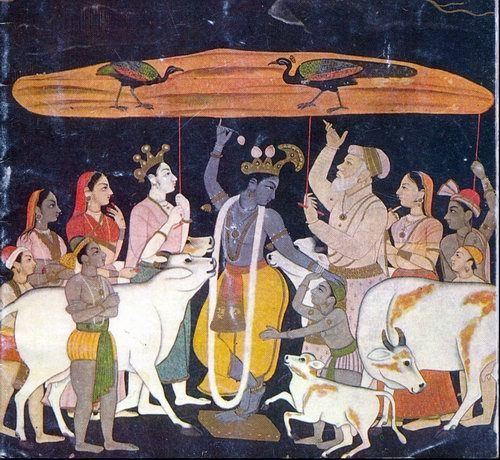 | ||
Tribhaṅga or Tribunga is a (tri-bent pose) standing body position or stance used in the traditional Indian sculpture, art and Indian classical dance forms like the Odissi. As compared with the contrapposto pose Tribhanga, literally meaning three parts break, consists of three bends in the body; at the neck, waist and knee, hence the body is oppositely curved at waist and neck which gives it a gentle "S" shape and is considered the most graceful and sensual of the Odissi positions. It has been closely associated with the Hindu deity Krishna who is often portrayed in this posture.
The Indian classical dance of Odissi is characterized by various Bhangas or stance, which involves stamping of the foot and striking various postures as seen in Indian sculptures, they are four in number, namely Bhanga, Abanga, Atibhanga and Tribhanga being the most common of all. The Sanskrit term Tribhanga means Three Bhanga and according to K. M. Varma the term Tribhanga is not the name of a particular standing position but is used in the Silpasastra literature to describe the group of the “Three Bhangas”, namely Abhanga, Samabhanga, and Atibhanga.
In sculpture
Like many other poses used in traditional Indian dance, including Odissi, Bharata Natyam and Kathak, Tribhangi or Tribhanga can be found in Indian sculpture as well. Traditionally the Yakshi is shown with her hand touching a tree branch, and a sinuous pose, tribhanga pose, as is Salabhanjika, whose examples dating to the 12th century can be found in the Hoysala temples of Belur, in south-central Karnataka and the Khajuraho temples built around 9th century CE, where Vishnu is depicted at various places in this position which commonly reserved for Krishna, playing the flute. The Agamic texts suggest that Shiva sculptures are to be made in tribhanga posture facing the east as seen in temple dating 8th-12th centuries.
The central deity at the Simhachalam temple near Visakhapatnam, the lion-man incarnation of Lord Mahavishnu is in the tribhanga posture. In the back it carries an inscription dating it 1098, the period of the Chola King Kuloththunga. The Tirumala Rama Idol at the famous Tirumala Venkateswara Temple, Andhra Pradesh is also in the same posture. This style has also travels with Indian influence as in China where some sculptures at the Maijishan Grottoes built in the Later Qin era (384-417 CE). Some Buddha images in Thailand are also in the tribhanga (leaning) position and so are some of Boddhisattva in the ancient Yakushi-ji Buddhist temples in Nara, Japan, built in 680 CE, the Hakuhō period.
